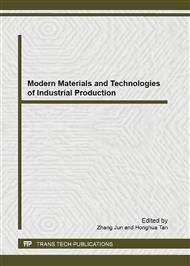p.157
p.163
p.171
p.177
p.181
p.186
p.192
p.196
p.200
Synthesis and Luminescent Properties of Red Phosphor BaY2O4: Eu3+ for White Light-Emitting Diodes
Abstract:
The rare-earth Eu3+ doped BaY2O4 red phosphor synthesized by citric acid sol-gel method. The structure, morphology and composition of the red phosphor were characterized by X-ray diffraction, scanning electron microscopy and infrared spectroscopy. The results show that the distribution of the pure phase BaY2O4: Eu3+ particles after annealing at 800 °C was irregular, small size of particle is 0.2 μm to 0.4 μm. The excitation spectra of synthesized phosphor at 610 nm monitoring were composed of a broadband and a series of sharp peaks, the strongest excitation peak at 466 nm, the secondly at 395nm. It was indicated that BaY2O4: Eu3+ phosphor matching with the widespread applied the output wavelengths of UV LED and blue LED chips. The main emission spectra of samples under blue light excitation is Eu3+ ions 5D07F2 electric dipole transition with a strong red light, so that the BaY2O: Eu3+ phosphor may be a better candidate for red component for white LED.
Info:
Periodical:
Pages:
181-185
Citation:
Online since:
September 2013
Authors:
Keywords:
Price:
Сopyright:
© 2013 Trans Tech Publications Ltd. All Rights Reserved
Share:
Citation:


